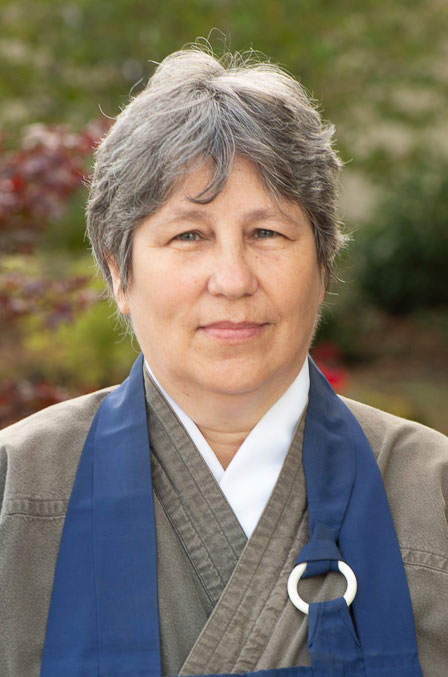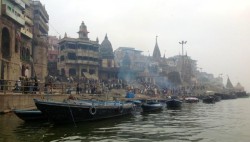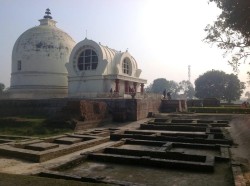Postcards From Roseapple Island*

Sallie Jiko Tisdale
Jiko’s Pilgrimage Journal Entries from India
Note: Center members Sallie Jiko Tisdale and Thomas Koshin Bruner have been in India from several weeks, visiting Buddhist sites, but also other placers of cultural and historical interest. *Jambudvipa, the ancient name for India used in Sutras.
Jan. 9 in Varanasi: We walked to the northern end of the ghats (bathing stairs) on the Ganges, finishing the entire 6-kilometer distance of more than 80 ghats, each of which has a distinct character. This was a distinctly local set of ghats without much tourist activity or design. Laundry everywhere – sheets and tablecloths and Calvin Klein boxer shorts and sarees and towels and t-shirts. They whack clothes on the rocks and wash and wring and whack again, in the filthy Ganges water which many Hindus believe cannot be dirty and is incapable of causing disease, and lay the sort-of clean clothes out on the dirty ghats to dry. Laundry of a kind. (The few Laundromats we’ve seen are not self-serve and advertise “laundry by machine.”) There are ghats with many ritual bathing platforms in a row, with bamboo scaffolding to (I think) set up wind breaks on. These have statue niches in front where you can only see the deity from the river, and only in dry season. There was a place filled with children, like a school yard; a place with many men playing cards; several boat yards; a place with a lot of goats; a huge stairway with crowd control stiles and not a soul on it. I hiked up in search of a toilet (the endless labor of women here, as there are very few public bathrooms), and it only ended up costing me Rs3000 of gorgeous silk scarves from a government silk factory (about $41 and all my Christmas shopping is done.) I had to push cows out of the way to leave the showroom, and that is Varanasi. We returned by rowboat and took a few distant photos of the

Varanasi – Photo by Thomas Bruner
big burning ghat, where photos are forbidden. This alone is worth pages.
We’re cold, though not as cold as you, I bet. Everyone asks, “What country?” They can’t tell us from Canadians or Germans, really. We say, “America” and the response is always, “Oh, very cold there!” That and the diplomatic flap about the maid is the big American news here.
Jan. 11 in Kushinagar:
We drove from Varanasi, leaving the hotel about 8:50 and trekking a fair distance through the alleys behind a line of hotel staff like porters, carrying out luggage. We arrived in Kushinagar at 7 pm – having traveled a total of about 200 kilometers in 10 hours.
Our driver is Prem-ji. He talks and mutters to himself in Hindi now and then, like drivers do, complaints and prayers; he talks on the phone often, driving then with one hand and tucking the phone under his ear so he can shift; we had about 150 kilometers of just plain bad road. The two-lane road was often reduced to one lane by breakdowns, torn-up sections, piles of bricks (we carefully climbed over one in the car), huge potholes, speed bumps where it would be impossible to go quickly anyway, and by many busy market towns filled with the usual crowd of motorcycles, bicycles, people, dogs, cattle; by traffic jams, one requiring us to turn around and back track three times; all requiring a near-constant swerving, down-shifting and careful negotiation of obstacles. It became like a video game; how will he get through? A bus ahead, a bus behind, a truck full of sugar cane coming toward us, motorcycles darting between? Oh, look, he found a small hole and we just fit.
This drive was through farming county, with lots of lovely mustard fields giving way eventually to wheat fields, and the spindly trees and palms giving way to large, old deciduous oak-like trees, with big crowns. Eventually we found the east-west highway and then Kushinagar, which is a very sleepy place, and then the Hotel Imperial, which is a big, cold, echoing empty place built for large tour buses, where we were the only guests. Brownouts at times, then blackouts, no internet, and when I asked for a map, the desk clerk said, “Our guest took the map.” Maybe they only had one of each.
Behind the wheat and cane fields next to the hotel, we saw the site for the distribution of Buddha’s relics, a Bodhi tree with a small locked shrine on one side, and lingam on the other; a Theravadin monk claims that he sleeps there 24 hours a day. There are many monasteries here, big and small, near and far. A few are open; we talked ourselves into the beautiful Thai monastery with a relics stupa.
The big draw is the Mahaparinirvana stupa with excavated brick monastic ruins and a tall round white stupa. There is a lovely giant reclining Buddha from about the 6th century with big head and big feet and gold lame blanket over the body. On one side is a niche with a touching little statue of the Buddha sitting backwards; I’ve never seen this before. Since it is possible to drive here from Burma, there are quite a few Burmese pilgrims here, mostly old women in small fluttering groups, and many sat meditation here. Finally we found the bathing ghat where Buddha washed when he knew he was dying, at the edge of a tiny Hindu shantytown – a sad place of thatch huts for cane workers, shabby deity houses, and a miserable cow. The ghat is a white staircase down to a dirty trash-filled canal with greenish water.
Past that is the stupa where the body was cremated and the relics collected. To our surprise, this was a serene and simple place, almost deserted: a big beehive-shaped brick structure, layers on layers of old bricks. Like every other Buddhist structure or statue we’ve seen, it has bits and pieces of gold flake wherever a person can reach; I believe this is done by Tibetans, who buy little squares of gold seal and press it to the brick. There is old candle wax running down in places as well, in spite of warning signs; pilgrims will not be denied.
– Jiko
PS: We’re fully in Muslim world now; Lucknow and then Agra, where the Taj Mahal and gardens are. I told Thomas the Buddha was dead to me now. A little Zen humor here in the beginning and end of things.
I finished my 108 bows with a final three at the cremation stupa.

